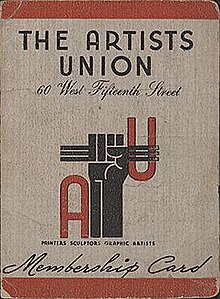
The Civil Works Administration (CWA) was a short-lived job creation program established by the New Deal during the Great Depression in the United States in order to rapidly create mostly manual-labor jobs for millions of unemployed workers. The jobs were merely temporary, for the duration of the hard winter of 1933–34. President Franklin D. Roosevelt unveiled the CWA on November 8, 1933, and put Harry L. Hopkins in charge of the short-term agency.
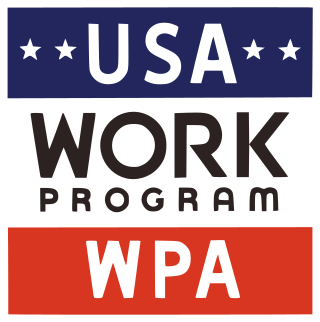
The Works Progress Administration was an American New Deal agency that employed millions of jobseekers to carry out public works projects, including the construction of public buildings and roads. It was set up on May 6, 1935, by presidential order, as a key part of the Second New Deal.

Federal Project Number One, also referred to as Federal One, is the collective name for a group of projects under the Works Progress Administration, a New Deal program in the United States. Of the $4.88 billion allocated by the Emergency Relief Appropriation Act of 1935, $27 million was approved for the employment of artists, musicians, actors and writers under the WPA's Federal Project Number One. In its prime, Federal Project Number One employed up to 40,000 writers, musicians, artists and actors because, as Secretary of Commerce Harry Hopkins put it, "Hell, they’ve got to eat, too". This project had two main principles: 1) that in time of need the artist, no less than the manual worker, is entitled to employment as an artist at the public expense and 2) that the arts, no less than business, agriculture, and labor, are and should be the immediate concern of the ideal commonwealth.

The Federal Emergency Relief Administration (FERA) was a program established by President Franklin D. Roosevelt in 1933, building on the Hoover administration's Emergency Relief and Construction Act. It was replaced in 1935 by the Works Progress Administration (WPA).

The Federal Theatre Project was a theatre program established during the Great Depression as part of the New Deal to fund live artistic performances and entertainment programs in the United States. It was one of five Federal Project Number One projects sponsored by the Works Progress Administration, created not as a cultural activity but as a relief measure to employ artists, writers, directors, and theater workers. National director Hallie Flanagan shaped the FTP into a federation of regional theaters that created relevant art, encouraged experimentation in new forms and techniques, and made it possible for millions of Americans to see live theatre for the first time. Although The Federal Theatre project consumed only 0.5% of the allocated budget from the WPA and was widely considered a commercial and critical success, the project became a source of heated political contention. Congress responded to the project's racial integration and accusations of Communist infiltration and cancelled its funding effective June 30, 1939. One month before the project's end, drama critic Brooks Atkinson summarized: "Although the Federal Theatre is far from perfect, it has kept an average of ten thousand people employed on work that has helped to lift the dead weight from the lives of millions of Americans. It has been the best friend the theatre as an institution has ever had in this country."
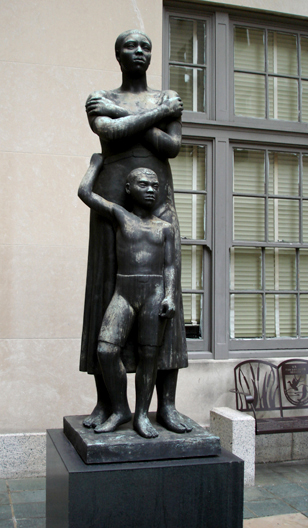
The Public Works of Art Project (PWAP) was a New Deal work-relief program that employed professional artists to create sculptures, paintings, crafts and design for public buildings and parks during the Great Depression in the United States. The program operated from December 8, 1933, to May 20, 1934, administered by Edward Bruce under the United States Treasury Department, with funding from the Federal Emergency Relief Administration.
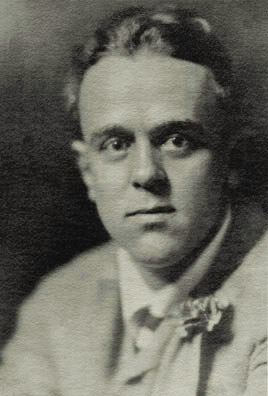
The John Reed Clubs (1929–1935), often referred to as John Reed Club (JRC), were an American federation of local organizations targeted towards Marxist writers, artists, and intellectuals, named after the American journalist and activist John Reed. Established in the fall of 1929, the John Reed Clubs were a mass organization of the Communist Party USA which sought to expand its influence among radical and liberal intellectuals. The organization was terminated in 1935.
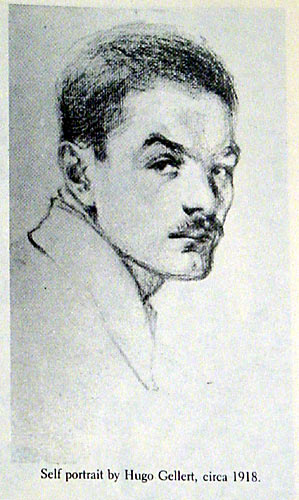
Hugo Gellert was a Hungarian-American illustrator and muralist. A committed radical and member of the Communist Party of America, Gellert created much work for political activism in the 1920s and 1930s. It was distinctive in style, considered by some art critics as among the best political work of the first half of the 20th century.

Louis Schanker was an American abstract artist.
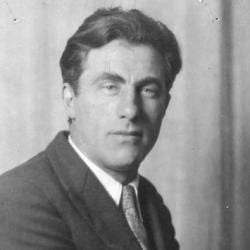
Harry Gottlieb was an American painter, screen printer, lithographer, and educator.

The Relief Appropriation Act of 1935 was passed on April 8, 1935, as a part of Franklin Delano Roosevelt's New Deal. It was a large public works program that included the Works Progress Administration (WPA), the National Youth Administration, the Resettlement Administration, the Rural Electrification Administration, and other assistance programs. These programs were called the "second New Deal". The programs gave Americans work, for which the government would pay them. The goal was to help unemployment, pull the country out of the Great Depression, and prevent another depression in the future. This was the first and largest system of public-assistance relief programs in American history, and it led to the largest accumulation of national debt.
American Abstract Artists (AAA) was founded in 1937 in New York City, to promote and foster public understanding of abstract art. American Abstract Artists exhibitions, publications, and lectures helped to establish the organization as a major forum for the exchange and discussion of ideas, and for presenting abstract art to a broader public. The American Abstract Artists group contributed to the development and acceptance of abstract art in the United States and has a historic role in its avant-garde. It is one of the few artists’ organizations to survive from the Great Depression and continue into the 21st century.

The New Deal was a series of programs, public work projects, financial reforms, and regulations enacted by President Franklin D. Roosevelt in the United States between 1933 and 1938 to rescue the U.S. from the Great Depression. It was widely believed that the depression was caused by the inherent market instability and that government intervention was necessary to rationalize and stabilize the economy.
The American Artists' Congress (AAC) was an organization founded in February 1936 as part of the popular front of the Communist Party USA as a vehicle for uniting graphic artists in projects helping to combat the spread of fascism. During World War II the organization was merged into the Artists' Council for Victory, which effectively spelled the end of the organization.

Winifred Milius Lubell was an American illustrator, artist and writer. In her early adult years, Milius was active in the Communist Party of the United States and an advocate for social justice. She began her artistic career creating pen and ink portraits of victims of the Great Depression, before proceeding to examine the struggles of the working poor in the towns of the Eastern United States through woodcuts, as well as producing drawings from the sit down strikes in Chicago. An artist and an illustrator, Milius' most notable publications include the illustrations for Dorothy Sterling's Cape Cod natural history book The Outer Lands. In her eighties she wrote and illustrated the women's studies exploration of feminism, sexuality and mythology: The Metamorphosis of Baubo, Myths of Woman's Sexual Energy. She died on January 3, 2012, of congestive heart failure. She was 97.

The Unemployed Councils of the USA (UC) was a mass organization of the Communist Party, USA established in 1930 in an effort to organize and mobilize unemployed workers.
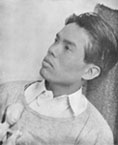
Hideo Noda, also known as Hideo Benjamin Noda and Benjamin Hideo Noda, was a Japanese-American modernist painter and muralist, member of the Shinseisakuha movement in Japan, student of Arnold Blanch, and uncle of Japanese printmaker Tetsuya Noda, as well as alleged communist spy recruited by Whittaker Chambers.
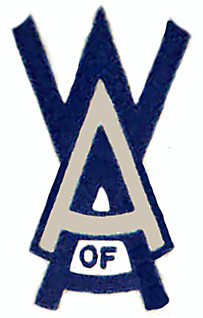
The Workers Alliance of America (WAA) was a Popular Front era political organization established in March 1935 in the United States which united several efforts to mobilize unemployed workers under a single banner. Founded by the Socialist Party of America (SPA), the Workers Alliance was later joined by the Unemployed Councils of the USA, a mass organization of the Communist Party USA (CPUSA), and by the National Unemployed Leagues originating with A.J. Muste's Conference for Progressive Labor Action (CPLA) and successor organizations.

The first term of the presidency of Franklin D. Roosevelt began on March 4, 1933, when he was inaugurated as the 32nd president of the United States, and the second term of his presidency ended on January 20, 1941, with his inauguration to a third term. Roosevelt, the Democratic governor of the largest state, New York, took office after defeating incumbent President Herbert Hoover, his Republican opponent in the 1932 presidential election. Roosevelt led the implementation of the New Deal, a series of programs designed to provide relief, recovery, and reform to Americans and the American economy during the Great Depression. He also presided over a realignment that made his New Deal Coalition of labor unions, big city machines, white ethnics, African Americans, and rural white Southerners dominant in national politics until the 1960s and defined modern American liberalism.
The Ten, also known as The Ten Whitney Dissenters, were a group of New York–based artists active from 1935 to 1940. Expressionist in tendency, the group was founded to gain exposure for its members during the economic difficulty of the Great Depression, and also in response to the popularity of Regionalism which dominated the gallery space its members sought.
